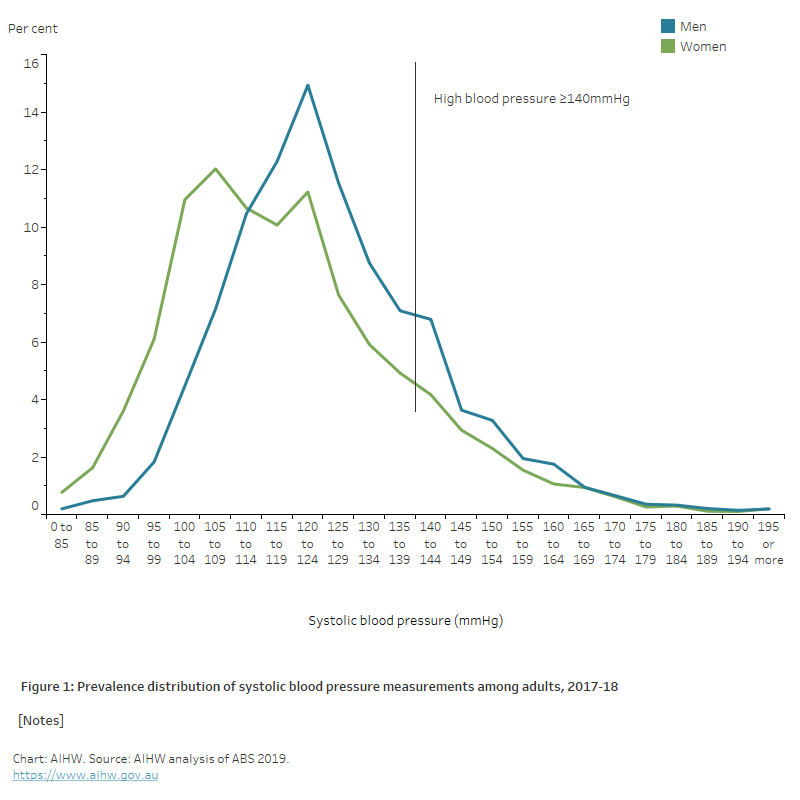High blood pressure
In 2017–18, based on measured data from the Australian Bureau of Statistics (ABS) National Health Survey (NHS):
- an estimated 34% of adults were living with high blood pressure. This included 23% living with uncontrolled high blood pressure and 11% whose blood pressure was controlled with medication.
- men were almost 1.3 times as likely to have uncontrolled high blood pressure compared with women.
- the proportion of adults with uncontrolled high blood pressure increased with age – from 7.5% among those aged 18–34 (10.2% men, 4.9% women) to a peak of 47% at age 85 and over (51% men, 48% women).
The proportion of Australian adults with high blood pressure has remained stable since 2011–12 (AIHW 2019).
Blood pressure is the force exerted by blood on the walls of the arteries, depending on whether the heart muscle is contracting (systolic blood pressure) or relaxing between contractions (diastolic blood pressure). High blood pressure, also known as raised blood pressure or hypertension, is where blood pressure is persistently higher than normal.
A person is considered to have high blood pressure if measured levels of systolic or diastolic blood pressure are high, regardless of the use of blood pressure medication.
Hypertension is commonly present among people with metabolic syndrome, including obesity, elevated blood glucose levels, insulin resistance and low high-density lipoprotein (HDL) cholesterol levels. These comorbidities, along with other risk factors, significantly increase the risk of developing diabetes (by over 2-fold) (Williams 2013).
In the ABS NHS 2017–18, persons aged 18 and over could consent to having a blood pressure measurement taken at the time of the interview. Participants who recorded a systolic blood pressure reading of 140mmHg or greater were counted as having a high blood pressure reading. Note that this only referred to the measurement at the time of the interview and does not necessarily indicate a chronic condition. For this survey, this is distinguished from 'Hypertension' which was self-reported as a long-term health condition.
Figure 1 and 1(a): Prevalence distribution of systolic and diastolic blood pressure measurements among adults, 2017–18
The two line charts show the distribution of systolic and diastolic blood pressure levels by sex in 2017–18.

Variation between population groups
After adjusting for different population age structures:
- The prevalence of uncontrolled high blood pressure was similar between remoteness areas in 2017–18.
- Uncontrolled high blood pressure was 1.3 times higher among those living in the lowest socioeconomic areas compared with the highest socioeconomic areas (AIHW 2019).
-
Indigenous adults were 1.3 times more likely to have high blood pressure in 2018–19 than non-Indigenous adults (AIHW and NIAA 2020).
ABS (Australian Bureau of Statistics) (2019) Microdata: National Health Survey, 2017–18, AIHW analysis of detailed microdata, accessed 1 December 2021.
AIHW (Australian Institute of Health and Welfare) (2019) High blood pressure, AIHW, Australian Government, accessed 1 December 2021.
AIHW and NIAA (AIHW and National Indigenous Australians Agency) (2020) Aboriginal and Torres Strait Islander Health Performance Framework 2020, Measure 1.07 High blood pressure, AIHW, Australian Government, accessed 1 December 2021.
Williams R (2013), 'Blood pressure and diabetes: a fatal attraction', European Heart Journal, 34 (44): 3395-3397, doi:10.1093/eurheartj/eht365.


